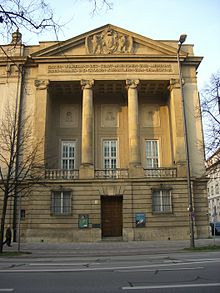Lehel
The Lehel ( sometimes pronounced in Bavarian with a short vowel and ch-sound: Smile ), also outdated St. Anna-Vorstadt , is a district of the Bavarian capital Munich . Together with the Altstadt district , it forms Munich's No. 1 Altstadt-Lehel district .
location
The Lehel is bordered by the Isar in the east and the Englischer Garten and the Thomas-Wimmer-Ring / Karl-Scharnagl-Ring in the west and the Max-Joseph-Brücke in the north and Zweibrückenstrasse in the south. The northern part of the Museum Island and the Prater Island also belong to the Lehel.
history

At the time of Ludwig the Bavarian at the beginning of the 14th century, many poor people who were not allowed to live in the city used the floodplain forest area, which was crossed by many streams. It was first mentioned in 1525 with “on the fiefs” (Lohe, light forest). The Lehel originally belonged to the Munich truce , but the duke had reserved certain rights. It was only when Elector Maximilian II Emanuel waived these reservations in 1724 that the Lehel fell fully under the jurisdiction of the city. This is often referred to somewhat imprecisely as "incorporation" into Munich. Since other areas of the Burgfriede were much less populated in the run-up to the city, the Lehel can be considered Munich's first suburb. Until 1812 it was also called the "outer Graggenauer quarter". In the course of the major city expansion, the area was officially called "St. Anna-Vorstadt" in 1812, analogous to the other suburbs such as Maxvorstadt . However, this name did not catch on. Up until the middle of the 19th century, day laborers and launderers lived in Lehel, often in small houses and hostels that were damp. Since the Lehel was a water-oriented area, mills, hammer mills, laundries, bleaching and gardens were found here. The old urban area with the Trift Canal and the associated storage areas for construction and firewood also belonged to the quarter. After the establishment of Maximilianstrasse and Prinzregentenstrasse in the second half of the 19th century, Lehel also became interesting for the bourgeoisie as a residential area. Open spaces were built on with tenement houses and administrative buildings in the style of historicism . On the site of the German national arts and crafts exhibition of 1888, a focus of upper-class representation developed. In the Second World War only slightly destroyed, the area is now the most part of this representative old buildings from the time of the German Empire . Because of this and because of the extremely central location, real estate prices are now among the highest in Munich. Retail and catering (larger shops are hard to find) are also more of the upscale category. During the Cold War, Radio Free Europe was located on Oettingenstrasse .
- Historical photos from Georg Pettendorfer's Lehel
Surname
There are various theories about the origin of the name of the district. One of them is that Lehel derives from Middle High German loh , i.e. H. “Light forest” comes because there were small riparian forests near the Isar . However, historical evidence shows that there was a small dukes' fiefdom in the area and that the name is derived from it. The oldest sources attest to Lehen (1525) and Lehel (1696).
Attractions
The Lehel is rich in sights. The sacred buildings of the parish church St. Anna im Lehel (St.-Anna-Str. 19), the monastery church St. Anna im Lehel (St.-Anna-Platz 5) and St. Lukas (Thierschstr. 28) can be found here . . At the same time, this quarter is home to outstanding museums and cultural institutes such as the House of Art (Prinzregentenstrasse 1), the Museum of Five Continents (Maximilianstrasse 42), the Bavarian National Museum (Prinzregentenstrasse 3), the Schackgalerie (Prinzregentenstrasse 9), the Alpine Museum as well the Czech Center (Prinzregentenstrasse 7) and the Polish Cultural Center (Prinzregentenstrasse 7). Other landmarks are the Maxmonument (at Maximilianstrasse 50), the Fortunabrunnen (Isartorplatz) and the Monopteros and Chinese Tower in the English Garden .
Trivia
The television series Meister Eder und seine Pumuckl was mostly filmed in a backyard at Widenmayerstraße 2 , where Meister Eder had his carpentry workshop. The Munich stories were also filmed here, the Häusler's house was at Tattenbachstrasse 3 .
literature
- Horst Feiler: Das Lehel: The oldest Munich suburb in the past and present . Buchendorfer, Munich 1994, ISBN 3-927984-27-2 .
- Horst Feiler: Das Lehel: The oldest Munich suburb in the past and present . MünchenVerlag, Munich 2006, ISBN 3-937090-13-4 .
- Helmuth Stahleder : House and street names in Munich's old town . Hugendubel, Munich 1992, ISBN 3-88034-640-2 , p. 199-212 .
Web links
- Lehel district on muenchen.de
Individual evidence
- ↑ http://www.tz.de/muenchen/stadt/viertel-alter-muenchen-tz-1064110.html
- ↑ Dr. Richard Bauer, Eva Graf: The city photographer. Georg Pettendorfer's views of Munich 1895-1935 . Heinrich-Hugendubel-Verlag, Munich 1989, ISBN 978-3-88034-447-1 , p. 198 .
- ↑ Katrin Hildebrand: Munich researcher explains how the city districts get their names. In: tz.de. Merkur tz Redaktions GmbH & Co. KG, August 4, 2017, accessed on May 28, 2019 .
Coordinates: 48 ° 8 ′ 19.7 " N , 11 ° 35 ′ 18.3" E






